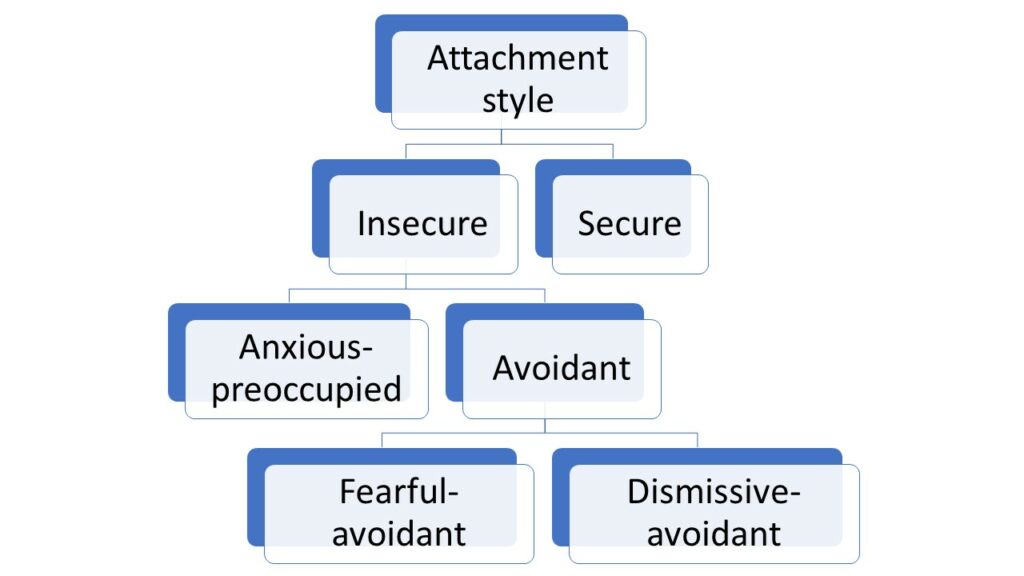The core principle of attachment theory is that how we interact with our primary caregivers in early childhood affects our adult relationships. In other words, our attachment style sets the ground rules for how we connect with other people.1Shaver, P. R., & Mikulincer, M. (2006). Attachment theory, individual psychodynamics, and relationship functioning. The Cambridge handbook of personal relationships, 251, 271.
Based on the interactions with her primary caregivers, a child can develop either a secure or insecure attachment.

a. Secure attachment
A securely attached child trusts their primary caregiver to be there for them. Their primary caregiver is a safe base from which they can explore the world. Secure attachment results from the caregiver being responsive to the child’s physical and emotional needs.
A securely attached child grows up looking for the same safety in relationships. They have no problems trusting and depending on people. As a result, they’re likely to develop reciprocal, healthy relationships.
b. Insecure attachment
If primary caregivers often or occasionally failed to meet a child’s basic physical and emotional safety needs, the child gets insecurely attached. Not having their essential needs met triggers two main coping strategies.
- Anxiety
- Avoidance
An anxiously attached child fears losing contact with her primary caregivers. Such a child grows up and becomes anxiously attached to relationship partners. Any sign of losing contact with their relationship partner triggers anxiety.
An avoidant child avoids their primary caregiver as a coping strategy. The child learns not to trust their primary caregiver/s to meet their needs. Such a child grows up with an avoidant attachment style where they tend to avoid people as much as possible.
Avoidant attachment style has two subtypes:
- Dismissive avoidant
- Fearful avoidant

Dismissive avoidant vs fearful avoidant attachment
A person with an avoidant attachment style learns early on that they can’t rely on others to meet their needs. What happens after that?
You either become highly self-reliant and seek to meet your own needs (dismissive-avoidant), or you develop a fear of close relationships (fearful-avoidant).
A person with a dismissive attachment style dismisses the importance of close relationships. They strive for independence and not depending too much on others.
But all human beings naturally desire to connect with and be somewhat dependent on others.
So, in dismissive avoidants, there’s this inner conflict between their natural need for connection and their desire for independence.
A person with a fearful avoidant attachment style simultaneously desires and fears close relationships. They tend to have a lot of surface-level relationships, but as soon as a relationship gets close, the fear of abandonment kicks in.
They’re afraid they’ll get hurt and betrayed if they get too close to someone. At the same time, they also have the natural desire to connect deeply.
Both being avoidant attachment styles, the dismissive and fearful avoidant attachment styles have some similarities. Let’s look at them before we dive deep into the differences.
Similarities between fearful and dismissive avoidants
1. Avoid getting attached
Both dismissive and fearful avoidants adopt an attachment avoidance strategy. They’re not comfortable with being too close to others.
2. Become defensive
Both dismissive and fearful avoidants can get defensive when others put too much demand on them to connect. They’ll naturally push away people who try to get too close to them.
3. Don’t trust easily
Both fearful and dismissive avoidants tend to have trust issues because they learned early on that others are incapable of meeting their needs.
4. Withdrawal behavior
Both dismissive and fearful avoidants respond to relational stress and conflicts by withdrawing from their partner (avoidance). When they fight in a relationship, they tend to withdraw from each other instead of tackling the conflict head-on.
Both push away their partners when they feel threatened in their relationship.
5. Need for alone time
People with fearful and dismissive attachment styles have a need for personal space. They need “me time” to recharge themselves.
6. Negative relational maintenance behaviors
Both attachment styles tend to engage in negative relational maintenance behaviors.2Murphy, B., & Bates, G. W. (1997). Adult attachment style and vulnerability to depression. Personality and Individual differences, 22(6), 835-844. These are designed to push away (avoid) their partners and include behaviors like:
- Spying on the partner
- Making the partner jealous
- Infidelity
Key points of difference
1. Perception of relationships
Fearful avoidants believe relationships are essential. However, they find getting too close to people difficult because they fear getting hurt or rejected.
Dismissive avoidants believe relationships are unimportant. They perceive relationships as an unnecessary burden. At the same time, they can’t seem to deny their basic need to connect.
2. Boundaries
Fearful avoidants have weak boundaries. They tend to have people-pleasing tendencies and care too much about what others think of them.
Dismissive avoidants tend to have firm boundaries. They hardly care what others think of them.
3. Openness
Fearful avoidants are open with people immediately, but they push back when they get too close.
Dismissive avoidants experience a tremendous amount of difficulty in opening up with people. They seem distant, and it takes a lot to open them up.
4. View of self and others
Fearful avoidants have a negative view of self but a positive view of others. They’re quick to blame themselves when things go wrong.
Dismissive avoidants have a positive view of self, resulting in high self-esteem. They generally have a negative view of others.
5. Anxiety
Fearful avoidants generally experience high anxiety in relationships. If they don’t talk to their partner frequently, they get anxious.
Dismissive avoidants barely experience anxiety in relationships. They can go for extended periods without communicating with their partner.
6. Behavior
Fearful avoidants display hot-and-cold behavior in romantic relationships. One day, they’ll shower you with love, warmth, and kindness. The next day, they’ll withdraw and be cold as ice.
Dismissive avoidants tend to exhibit a general coldness. Coldness is their default behavior, but they’ll occasionally be warm too.
7. Rejection response
Being afraid of rejection, fearful avoidants have an adverse reaction to it. If you reject them intentionally or unintentionally, be prepared for a lashing out.
Dismissive avoidants have an ‘I don’t care’ attitude about rejection. They’re okay with rejection because they believe relationships don’t matter anyway.
8. Source of pride
Because fearful avoidants have a positive view of others, good relationships are a source of pride.
For dismissive avoidants, self-reliance is a source of pride.
9. Moving on
It can be challenging for fearful avoidants to move on from relationships.
Dismissive avoidants can easily move on from relationships. They may even experience relief when a relationship ends.
10. Response to conflict
When there’s a conflict or stress in a relationship, fearful avoidants will show a combination of ‘approach’ and ‘avoidance’ behaviors. They’ll push you away intensely, then come back and shower you with love intensely.
Dismissive avoidants avoid their partner and the relationship completely in times of stress. They can completely shut down their emotions and disconnect.
11. Moods
Fearful avoidants tend to have a stormy emotional life. This is, to some extent, indicative of the internal conflict between love and fear that they go through.
One positive gesture from your end, and they feel tremendously loved. One negative gesture from your end and they feel tremendously rejected.
Dismissive avoidants tend to have a more stable inner life.
12. Depression
Fearful avoidants are prone to feeling depressed, given the self-criticism they engage in.3Goodboy, A. K., & Bolkan, S. (2011). Attachment and the use of negative relational maintenance behaviors in romantic relationships. Communication Research Reports, 28(4), 327-336. They’re likely to talk about and threaten self-harm when things go south.
Dismissive avoidants are not prone to depression, mainly because they have a high level of self-esteem.
13. Emotional expression
Fearful avoidants are good at expressing their emotions. They tend to wear their hearts on their sleeves.
Dismissive avoidants experience an aversion to expressing their emotions. They’re good at suppressing/repressing their negative emotions.
14. Friendships
Fearful avoidants often make friends easily because they come across as warm and open from the start.
Dismissive avoidants struggle to form close friendships. Even if they like someone, they’ll resist starting a friendship with them.
15. Triggers
Things that trigger a fearful avoidant:
- Becoming attached
- Inferiority
- Blame
- Criticism
Things that trigger a dismissive avoidant:
- Demands
- Tantrums
- Drama
- Criticism
16. Social support
Fearful avoidants tend to have a strong network of social support. They have no problems getting things done through others.
To a dismissive avoidant, relying on others is weak. Therefore, they lack a strong social support system.
17. Fears
Fearful avoidants are afraid their romantic relationship will end. It’s challenging for them to work through their defenses and form close attachments to others. They don’t fall in love too easily.
Dismissive avoidants can fall in love easily, but they’re afraid of commitment. Commitment seems to go against their core value of freedom. They feel trapped when they have to make a commitment.
They also fear losing themselves and their cherished ‘space’ in the relationship.
18. Disagreement tolerance
Fearful avoidants have a low tolerance for disagreements in a romantic relationship. To them, disagreement equals rejection. And remember, getting rejected is one of their worst fears.
To a dismissive avoidant, disagreements are normal and expected. They don’t feel rejected when their partner disagrees with them. They have a high tolerance for disagreement.
19. Warming up after a conflict
Fearful avoidants can warm up quickly after a conflict. This is because, even though they withdraw in the face of relational stress, they also have high anxiety that can become intolerable.
Dismissive avoidants take a long time to warm up after a conflict. They require a significant amount of time and space to process their emotions. Eventually, they do warm up.
20. Reading nonverbals
Fearful avoidants are often emotionally disconnected from their romantic partners. They can detect the slightest changes in their partner’s facial expressions and other nonverbals.
Unless they’ve worked on it, dismissive avoidants aren’t good at nonverbal communication.
21. Common quotes
Things that fearful avoidants will say to their partner:
- “You’re my home.”
- “You’re my safe place.”
- “You won’t leave me, right?”
Things that dismissive avoidants often say:
- “You can’t trust anyone.”
- “I don’t need anyone.”
- “I can be alone forever.”
Summary
| Point of difference | Fearful avoidant | Dismissive avoidant |
| Relationships perception | Important | Unimportant |
| Boundaries | Weak | Strong |
| Openness | Immediately open | Take time to open up |
| View of self and others | Self = negative; Others = positive | Self = Positive; Others = Negative |
| Anxiety | High | Low |
| Behavior | Hot-and-cold | Cold |
| Rejection response | Afraid of rejection | Unafraid of rejection |
| Source of pride | Relationships | Self-reliance |
| Moving on from a relationship | Difficulty moving on | Easily move on |
| Response to conflict | Approach/avoidance | Avoidance |
| Moods | Mood swings | Stable moods |
| Depression | Prone to depression | Not prone to depression |
| Emotional expression | Free | Constrained |
| Friendships | Many | Few or none |
| Triggers | Attachment; Inferiority; Blame; Criticism | Demands; Tantrums; Drama; Criticism |
| Social support | Strong | Weak |
| Fears | Relationship ending | Commitment |
| Disagreement tolerance | Low | High |
| Warming up after conflict | Fast | Slow |
| Reading nonverbals | Good | Poor |
| Common quotes | “You’re my home.” “You’re my safe place.” “You won’t leave me, right?” | “I don’t need anyone.” “I can be alone forever.” “No one can be trusted.” |
